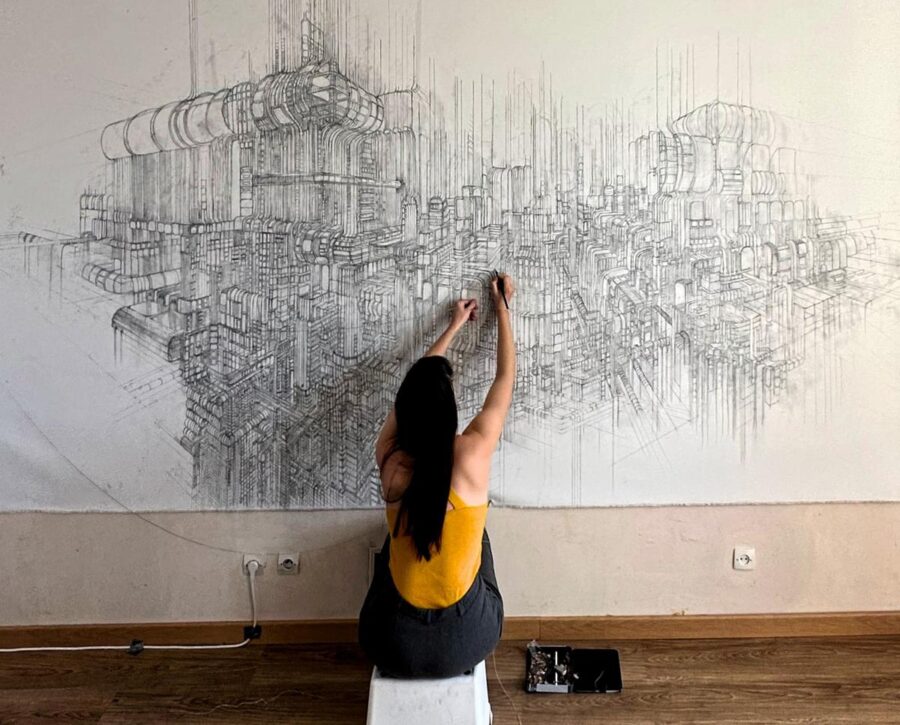Can art be a map of the mind, unfolding over years, serving as both creation and therapy? In an era characterized by fleeting impressions and the constant acceleration of information flow, an unwavering dedication to a singular, monumental artistic vision emerges as a profound counter-narrative. It is the story of an artist who not only creates images but designs entire worlds that unfold over years, layer by layer, line by line. Margritt Martinet, a contemporary French artist, embodies this devotion in a way that is both captivating and thought-provoking. Her work is a continuous journey into the depths of the human mind, manifested in dreamlike constructs and surreal urban landscapes that make the intangible visible.
The Creator of Inner Worlds: Context and Artistic Genesis
The artistic landscape is rich with names that echo through history, and it is crucial to precisely locate the identity of the artist under consideration here. Margritt Martinet is a contemporary French artist whose work is rooted in the here and now. Her creations, characterized by large-scale, futuristic urban landscapes in pencil and ink, stand in stark contrast to those of Marjorie D. Martinet (1886–1981), an American artist known for her regional landscape paintings and teaching. This distinction is not merely a matter of accuracy but also underscores the unique position Margritt Martinet holds in the current art scene. Her focus on detailed, speculative constructs fundamentally differs from the historical depictions of her namesake, pointing to an entirely different artistic agenda and cultural context.
The driving force behind Margritt Martinet’s art stems from a deep, often described as “unexplainable,” part of her psyche. It is an existential need to transfer her innermost thoughts and emotions onto paper, to create a kind of “map of her brain.” This imperative urge is not merely a preference for a creative method but a fundamental psychological necessity. Her creative process is deeply intuitive; she allows “everything in her head to flow out” and often begins “several large-format works simultaneously,” shifting between them according to her “mood and thoughts.” This approach, where she does not know the final outcome in advance but discovers the “shapes, lines, curves, and hidden details” of her future drawing step by step, reveals that the art itself is a living, evolving entity. It reflects the fluidity of thought and emotion. This continuous unfolding of the artwork, as Margritt Martinet discovers it, also implies a personal transformation through the act of creation. It is a process of becoming, for both the work and the artist herself.

The Precision of Vision: Artistic Signature and Technique
Margritt Martinet’s artistic signature is unmistakable and characterized by a fascinating duality. She transforms black ink with fine liners and a ruler into dreamlike constructs, charting “surreal urban landscapes layer by layer, line by line.” Her works are distinguished by “complex grids and labyrinthine structures” that appear “stacked one upon the other like an overcrowded city.” The style is marked by an “impressive monochrome,” where “every line is intentional, every angle precise.” This meticulous accuracy, expressed through the use of a ruler and an emphasis on precision, stands in remarkable contrast to her previously described intuitive and organic creative process.
This apparent contradiction is a central element that makes Margritt Martinet’s artistic signature intellectually compelling. The juxtaposition of an “instinctive” and “organic” creative flow with the “precise,” “intentional,” and “structured” nature of her lines reveals an artist who possesses both boundless imagination and rigorous discipline. Here, the subconscious finds its expression in highly structured forms. Precision is the language through which intuition speaks; the “map of her brain” is not chaotic but a highly organized, albeit complex, inner landscape. The initially “loose geometric sketches” are “slowly refined,” indicating a controlled development. This reveals a sophisticated artistic intelligence that channels raw creative energy into disciplined, captivating visual narratives.
The choice of her materials is also an integral part of her artistic statement. Margritt Martinet uses pencil and ink and explicitly emphasizes the use of BIC products. She highlights that BIC’s “affordable range of products allows artists to pursue their passion without the burden of high costs,” proving that “great art does not always require expensive materials.” This conscious decision for accessible, everyday materials is more than just practical; it is a powerful stance in the contemporary art world. It presents a subtle critique of the commercialization and often elitist perception of art, suggesting that authentic artistic expression does not depend on costly tools but on vision and dedication. This democratizes the act of creation and can inspire a broader audience as well as aspiring artists. Her preference for the “texture of pencil on paper” and the “lightness” these tools offer also reveals a deep, almost tactile relationship with her medium, reinforcing the intimacy of her creative act as a direct projection of her inner self.
Echoes of the Psyche: Identity, Memory, and Transformation
Margritt Martinet’s art is inextricably linked to her inner experience, as manifested in her explicit statement: “My process is a kind of therapy; without drawing, I couldn’t live ‘normally’.” She describes it as a “vital need for me to be able to get everything out of my head onto paper” and refers to her work as a “map of her brain,” reflecting her “inner thoughts and emotions.” These statements establish a direct connection between her creative practice and her mental balance. They elevate her work beyond mere aesthetic contemplation to a deeply personal, almost existential act of self-preservation and integration. The complex urban landscapes thus become more than just visual constructs; they are tangible manifestations of her inner landscape, a continuous process of externalization and understanding of her own identity and emotional states. This correlates with broader contemporary discussions about art and mental well-being, positioning Margritt Martinet as a poignant example of the therapeutic power of art.
The extraordinary time investment Margritt Martinet dedicates to her large-scale drawings is another central feature of her work. Projects like “Maxi Bibulle” took four years to complete, and her current work, “Maxi Futur/amas,” has been in development for four years. This multi-year duration of her projects is not just a logistical detail but a profound statement in the context of contemporary art, which often values rapid production and immediate impact. This extended timeframe situates her work within a “slow art” movement, where the creative process itself becomes a journey of endurance and continuous transformation. Each line added over years contributes to a cumulative narrative, implicitly forming a type of memory within the artwork itself, a memory of the artist’s evolving thoughts, moods, and dedication. The artwork transforms from an initial concept into a complex, multifaceted entity that mirrors the slow, organic development of a city or, in a deeper sense, a mind. This sustained engagement with her works is a testament to the unwavering nature of her artistic calling and the profound impact the process has on shaping her identity and expressing her inner world.

The Unfolding Narrative: Major Works and Reception
The essence of Margritt Martinet’s artistic achievement manifests in her monumental projects, which demand years of dedication. Two of her most renowned works, “Maxi Bibulle” and “Maxi Futur/amas,” serve as striking examples of the sheer scale and complexity of her vision. “Maxi Bibulle” is described as a “massive nebula of countless ‘bubbles'” that coalesce into an organic whole, taking four years to complete. Her latest endeavor, “Maxi Futur/amas,” also four years in the making, presents “complex grids and labyrinthine structures, stacked one upon the other like an overcrowded city.” These works are not merely static depictions but dynamic worlds that invite the viewer to get lost in their infinite details. They are the tangible result of her unique process and tireless devotion, redefining the boundaries of drawing.
The reception of Margritt Martinet’s art is closely linked to her deliberate presence on digital platforms, which represent a modern strategy for artistic dissemination and discourse. Her works are featured on renowned art portals, and she is a prominent face of the “BIC Creators” series. Her active presence on social media is a clear indication that she leverages the opportunities of the digital world to reach a broad, often younger and digitally native audience, extending beyond traditional gallery spaces. This digital engagement, combined with her choice of affordable materials, reinforces an overarching theme of accessibility and democratization of art.
This comprehensive digital presence is more than just a marketing strategy; it is an integral part of her artistic narrative and reception. For an artist whose works take years to create, digital channels offer a continuous opportunity to share not only the finished product but also the process of creation. Her collaboration with BIC, a company known for its accessible products, aligns perfectly with her own philosophy on materials. This demonstrates that Margritt Martinet is a contemporary artist who understands and skillfully utilizes modern media to shape her reception and participate in the broader art discourse. Her ability to make complex and time-intensive art accessible to a global audience fosters a wider appreciation for contemporary art and its creation, helping to blur the lines between art and everyday life.
Beyond the Canvas: Cultural Resonance and Artistic Discourse
Margritt Martinet’s art is not merely a visual representation but a profound commentary on human existence in an increasingly complex and densely populated world. Her “futuristic cityscapes” and “surreal urban landscapes,” through which one can imagine “hover cars and spacecrafts gliding,” are far more than mere fantastic constructs. They function as poignant metaphors for the multifaceted, sometimes overwhelming nature of modern life and the human mind itself. The motif of the “overcrowded city” and “twisted worlds” can be understood as a mirror for the psychological and social realities of our time. Her works invite the viewer to reflect on themes such as expansion, limitation, and the incessant human urge to create and inhabit, both physically and psychologically. Thus, Margritt Martinet positions herself within a broader artistic discourse that uses speculative visions to reflect on present realities and future possibilities. Her art is therefore a contribution to an ongoing conversation about the future of urbanization and humanity’s role within it.
The sheer time Margritt Martinet invests in her projects, often years of uninterrupted work, is an act of profound artistic perseverance in an era characterized by instant gratification and fleeting trends. This dedication itself becomes part of the artwork’s narrative, imbuing it with a sense of enduring value and quiet resilience against the ephemeral. It becomes clear that true artistic depth often requires sustained engagement that transcends immediate reward. Her creative process offers a model for a practice that prioritizes introspection and gradual unfolding. Her work thus stands as a testament to human patience and the transformative potential of long-term artistic devotion. It is a reminder that the deepest and most meaningful creations often emerge from a process of slow growth and continuous refinement, which views time as an ally rather than an adversary.

The Infinite Horizon of the Mind
Margritt Martinet’s work is a powerful answer to the question of whether art can be a map of the mind. Her meticulously drawn, futuristic urban landscapes extend far beyond mere visual representation; they become profound explorations of the human psyche, identity, and the incessant flow of inner experiences. Every line Margritt Martinet lays down over years is a brushstroke on this mental cartography, a testament to her artistic endurance and the therapeutic power of creation. Her art is not only a mirror of her innermost thoughts and emotions but also a vital outlet that allows her to organize and comprehend the complexity of her mind.
In a world that often craves rapid completion, Margritt Martinet’s long-standing commitment to her projects stands as a quiet yet powerful act of perseverance. It is an artistic practice that integrates time itself into the creative process, transforming the works into living archives of their own evolution and the artist’s transformation. Her ability to create worlds of such complexity and depth with simple, accessible materials democratizes art and invites everyone to recognize the infinite possibilities of creative unfolding. Margritt Martinet’s work reminds us that the most captivating landscapes are often those meticulously mapped from within, inviting us to lose ourselves in their infinite details and find echoes of our own complex inner worlds. It is a call to contemplate the boundless, ever-shifting horizons of both the imagined future and the human mind itself.









